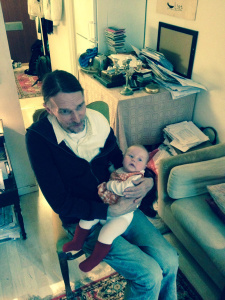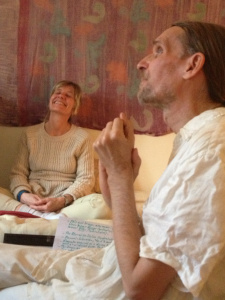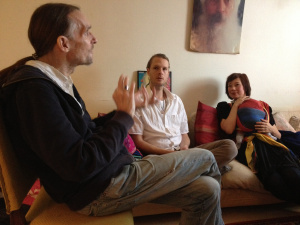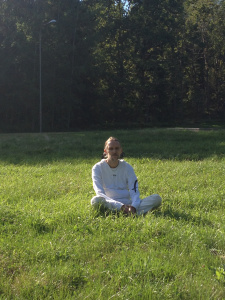Swami Dhyan Giten's Blog, page 22
February 12, 2016
Satsang with Giten on Buddha: Bhumis & Paramitas: 2. Grace in Living, Innocence, Simplicity
Satsang with Giten on Buddha:
Bhumis
– Ten Steps to
Enlighten
ment
From Satsang with Giten, February 11, 2016, in Stockholm
2. VIMAL: Innocence, purity and simplicity
The second Bhumi is VIMAL, which means innocence, purity and simplicity.
Innocence is learning to love, respect and accept yourself as you are.
Innocence is learning to trust yourself, to trust other people and to trust life.
To be innocent is to be childlike.
To be childlike does not mean to be childish. It does not mean to be a child, but to be like a child.
To be childlike and to be childish are totally different.
To be childish is to be irresponsible and immature and to be like a child means to be simple, trusting and innocent.
This is what Jesus means when he says that you have to be like a child to enter into the Kingdom of God.
In old Buddhist scriptures it says that Jesus studied at a Buddhist university in India before he began to preach, so this saying of Jesus could come from this Bhumi.
If you become knowledgeable, you lose innocence, you lose your heart.
If you gather beliefs and knowledge, your innocence will become corrupted. You lose the simplicity of being.
When I had a consultation with a spiritual teacher many years ago, she said to me: Never lose your innocence.
Never lose your innocence, your childlikeness, and much will happen.
On the second Bhumi, the meditator also develops the second Paramita, SHILA, which means grace in living. Grace in living means to live a live of compassion, love and gratitude.
It means to live a life that cares for others.
On the second Bhumi, the meditator and bodhisattva, the buddha in essence, overcomes all tendencies towards negative actions. He fulfills pure and virtuous actions and abandons killing, stealing, lying, harsh speech, senseless chatter, harmful intent and actions that is harmful to other living beings through actions of the body, mind and speech. The second Bhumi is also related to karma.
The bodhisattva’s mind becomes pure, which is a prerequisite to going deeper into silence, emptiness and meditation through the ten Bhumis.
It is to remove everything that stands between ourselves and the inner silence and emptiness step by step.
– Swami Dhyan Giten
Satsang with Giten on Buddha:
Paramitas
– The Ten
Provisions
for the
Inner Journey
From Satsang with Giten, February 11, 2016, in Stockholm
2. Grace in Living
The second Paramita is SHILA, which means grace in living.
It means to live a life of grace, compassion, love and gratitude.
It means to live a life, which is responsible and which cares about others.
Buddhists have misinterpreted SHILA and thinks that it means morality and a rigid character.
Buddha says: The second Paramita is grace in living, a discipline that has arisen out of understanding.
SHILA refers to purity of thought, word and deed.
The conditions of SHILA is love, awareness, silence and calm, where you no longer are susceptible to the passions of selfishness and greed.
Buddha says: Unless you have discipline, the capacity to learn, you will not develop grace in living, the discipline that arises out of understanding.
The word “discipline” means: readiness to learn. When one is open to learn one is very aware, because learning is only possible when you are aware. When you are not aware you cannot learn anything.
A man of understanding learns from everywhere. Then there is grace.
One of the most vital distinctions in a person’s spiritual life is to understand that the way is from in to out, not from out to in.
When we change the inner, the outwards follows.
When we find the love, awareness and silence within, grace in living arises on the outside.
– Swami Dhyan Giten


Satsang with Giten on Buddha: The Eightfold Way – Right Livelihood
Satsang with Giten on Buddha:
The Eightfold Way
From Satsang with Giten, February 11, 2016, in Stockholm
5. Right Livelihood
The fifth step on Buddha’s eightfold way is Right livelihood.
Right livelihood can also be called right way of living.
Buddha says: Life should be simple, not complex.
Life should be based on needs, not on desires.
You need basic needs like love, relationships, clothes and a shelter.
Needs can be fulfilled easily, desires are endless and unfillable.
The first things about Right livelihood is that it should be based on needs, not on desires.
The second things about Right livelihood is that it should not be based on violence and on hurting other people.
Buddha warns against occupations that harm other beings and suggests that we avoid any occupation that would violate the principles of Right Speech and Right Action.
Right livelihood brings up important questions about work and creativity: How to make work meaningful and satisfying? How work can become a meditation and play and not a hindrance to develop awareness and meditation?
– Swami Dhyan Giten
GITEN ON YOUTUBE:
SPIRITUAL TEACHER AND AUTHOR SWAMI DHYAN GITEN’S LECTURE IN ENGLISH ON INTUITION – THE INNER SOURCE OF LOVE, TRUTH AND WISDOM
– FOR FREE DOWNLOAD ON YOUTUBE
“Intuition means to follow the whispers of the inner in a basic ‘yes’ to life.”
-Swami Dhyan Giten
Giten’s lectures works on two levels, on two dimensions: the words and the silence beyond the words.
Prem Mukta, a participant in Satsang with Giten in Stockholm, wrote a mail to Giten a couple of days ago, saying that she felt a need to record Giten’s lectures during Satsang to be able to listen to them again.
She writes: “Giten manages to deliver so much wisdom and interesting information in a short while during Satsang that I want to save everything, and put in a little shrine for further contemplation.”
“I listened several times to Giten’s English lecture on Intuition – The Inner Source of Love, Truth and Wisdom. The lecture felt total, direct and provoked my mind. First after a while, I could let go and begin to listen to the words.”
– Deva Emanuel, musician, composer and student of Giten since 6 years
“Giten’s voice in the head phones becomes the finest company during walks.”
– Prem Mukta, Stockholm
Download the leture for free on YouTube:
https://www.youtube.com/watch?v=JMyQZGQND30


February 9, 2016
Giten on YouTube: Spiritual teacher and author Swami Dhyan Giten’s lecture on Intuition – The Inner Source of Love, Truth and Wisdom – for free download on YouTube
GITEN ON YOUTUBE:
SPIRITUAL TEACHER AND AUTHOR SWAMI DHYAN GITEN’S LECTURE ON INTUITION – THE INNER SOURCE OF LOVE, TRUTH AND WISDOM – FOR FREE DOWNLOAD ON YOUTUBE
“Intuition means to follow the whispers of the inner in a basic ‘yes’ to life.”
-Swami Dhyan Giten
Giten’s lectures works on two levels, on two dimensions: the words and the silence beyond the words.
Prem Mukta, a participant in Satsang with Giten in Stockholm, wrote a mail to Giten a couple of days ago, saying that she felt a need to record Giten’s lectures during Satsang to be able to listen to them again.
She writes: “Giten manages to deliver so much wisdom and interesting information in a short while during Satsang that I want to save everything, and put in a little shrine for further contemplation.”
“I listened several times to Giten’s English lecture on Intuition – The Inner Source of Love, Truth and Wisdom. The lecture felt total, direct and provoked my mind. First after a while, I could let go and begin to listen to the words.”
– Deva Emanuel, musician, composer and student of Giten since 6 years
“Giten’s voice in the head phones becomes the finest company during walks.”
– Prem Mukta, Stockholm
Download the leture for free on YouTube:
https://www.youtube.com/watch?v=JMyQZGQND30


February 5, 2016
Satsang with Giten on Buddha: Bhumis – Ten Steps to Enlightenment
Satsang with Giten on Buddha:
Bhumis – 10 Steps to Enlightenment
From satsang with Giten, February 4, 2016, in Stockholm
What are Bhumis? Buddha’s Way has ten Bhumis. Bhumi means ground, foundation or level of development.
The first Bhumi is attained when the meditator achieves his first insight into emptiness in meditation. With each of the ten Bhumis the meditator achieves deeper realization of emptiness in meditation.
Buddha has said that if you understand and practice these ten grounds, you will attain to the ultimate. The Bhumis are the Bodhisattva path to enlightenment.
1. PRAMU-GITA: The first Bhumi – Joyousness
The first Bhumi, the first ground, is joyousness.
Pramu-Gita means joyousness, delight, and celebration.
The first Bhumi is called Joyousness, because the meditator also works at developing generosity, the first Paramita, the first of the ten provisions on the spiritual path. The ten Bhumis and the ten Paramitas are developed simultaneously.
People have thought that Buddha is a sad and pessimistic thinker, because he says that life is suffering, but he is not.
Buddha says: Unless you are joyous, you will never reach to truth.
Only joy can take you to truth.
Truth brings joy, truth brings happiness.
The first Bhumi means: to be joyous for no outer reason.
Ordinarily to be joyous has a reason, but if your joy has a cause, it will soon turn into unhappiness.
The first Bhumi is about joy without any cause, and then joy becomes your own source happiness, which nobody can take away.
Buddha says that the frist Bhumi is about the awareness, where you create joy and happiness for yourself.
– Swami Dhyan Giten


Satsang with Giten on Buddha: Paramitas – The Ten Provisions for the Inner Journey

Satsang with Giten on Buddha:
Paramitas – The Ten Provisions on the Inner Journey
From satsang with Giten on Buddha, February 4, 2016, in Stockholm
What are Paramitas? You will have to bring provisions for the inner journey, you have to carry provisions for the journey.
Buddha has called these provisions Paramitas.
The ten Paramitas are qualities, which will help you on the inner journey.
Paramita means that which can lead you beyond.
They have to be understood very deeply.
1. DANA: Generosity, sharing
The first Paramita is generosity, sharing.
Buddha says: Dana, generosity, sharing, has to be learned.
Learn to share as much as possible.
Share whatsoever you have to share.
Ordinarily the mind is a miser, the mind is not generous.
Miserliness is a close mind.
Miserliness is a separation from other people and from the world. It is a separation from life.
Generosity is to be open to the world. It is to be open to life.
Buddha says: The first Paramita of generosity, sharing, will help to lead you beyond.
Whether you share your love, your joy, your creativity, your experience, your meditation, your money, your house, your clothes or your body is not important. The important thing is the sharing.
The ordinary mind is hoarding. The mind have much involvement with your love, your body, your money and your house.
The mind clings to this shore of existence. All the hoarding of the mind belongs to this shore.
You cannot take anything with you from this shore, but you can learn to share. You can carry a generous and sharing mind. You cannot carry your money, but you can carry your love, your generosity and your compassion.
Buddha says: If you have love and compassion in your heart, existence will reflect you. Existence always reflects you. If you share, existence will share with you.
If you are miserly and hoarding, it means you are against existence, which is always sharing and celebrating.
The miserly and hoarding mind is afraid, it does not trust. It does not trust existence.
It trust things, it does not trust the whole, the infinite.
Buddha says: If you trust, then existence responds in the same way.
Existence is a mirror.
Buddha says: Be non-possessive; posses neither this shore nor the other shore of existence.
Be always sharing.
Buddha says: Shower your meditation. If you attain to meditative states, share it immediately.
A real meditative quality wants to be shared.
If your meditation does not become compassion, then your meditation is not going right.
Buddha says: before death takes things away from you, share them.
People just want to have, but they do not want to give.
Buddha says: Learn give-think. Learn the ways of sharing and you will flower.
Then generosity will become your quality. It will become a quality of compassion on your path to truth, to enlightenment.
– Swami Dhyan Giten


February 3, 2016
Hopkinton Middle School in Massachusetts, USA, quotes Giten on Acceptance in a curriculum designed to educate students about the acceptance of and respect for others in the community and in the world.

88 Hayden Rowe St | Hopkinton | MA 01748 | Phone: 508-497-9830 | Fax: 508-497-9803
Hopkinton Middle School in Massachusetts, USA, quotes Giten on Acceptance in The Power of WE, which is a curriculum designed and implemented by the Middle School Counseling Department. The mission of the Hopkinton Publich Schools is to learn, create, and achive together.
New in 2015-16, its goal is to introduce students to a new theme each year which will challenge them to think about themselves and the world around them. This year’s theme,ACCEPTANCE, strives to educate HMS students about the acceptance of and respect for others in our community and our world.

The Power of WE: Make a positive (+) difference today!
The Power of WE is a curriculum designed and implemented by the Middle School Counseling Department. New in 2015-16, its goal is to introduce students to a new theme each year which will challenge them to think about themselves and the world around them. This year’s theme,ACCEPTANCE, strives to educate HMS students about the acceptance of and respect for others in our community and our world. HMS students were introduced to this new theme by their grade level Counselor in September.
The Power of WE curriculum consists of three elements: weekly Google Slide presentations that include a 2-5 minute media clip followed by a take away lesson and weekly challenge; classroom lessons delivered by the School Counselors on a trimester basis; and school-wide events and activities. Following the theme of acceptance, this year’s curriculum is broken into three sub-themes that look at acceptance from a community level, a peer level and a self level. First semester focused on diversity (community level) – the acceptance and respect for people from other races, religions, abilities, etc. Now, currently in second trimester, our focus has moved towards peer acceptance as we discuss bullying and healthy friendships. Finally, during the third trimester, the curriculum will turn to the importance of self-acceptance.
The first trimester kick-off of Power of We was deemed a success by students, teachers and administration. Students report looking forward to the videos on Monday mornings as a great way to start their week, giving them something to think about as they go through their routines. Many teachers have taken the weekly themes and found ways to integrate them into already planned lessons, propelling students to find ways to meld the classroom with “real life.” Behavior changes are already being noticed across the school by students and staff, demonstrating that the program’s ideas are taking root.
The Power of WE curriculum meets several standards required through the Massachusetts Comprehensive Health Curriculum Framework. Specifically, Standard 7.7 states that by the end of Grade 8 students will “Recognize the positive contribution of character traits (such as tolerance, honesty, self-discipline, respectfulness, and kindness) to relationships, the benefit of which include understanding and respecting individual differences, and the detrimental effect of prejudice (such as prejudice on the basis of race, gender, sexual orientation, class, or religion) on individual relationships and society as a whole.”
We are very proud to have introduced this program this year and have already begun working on next year’s installment of the program. Weekly presentations can be found below. We encourage families to review these presentations with their children at home and have discussions about how the messages resonate in other areas of their lives. In addition to accessing the current week’s presentation, the Power of WE webpage also provides an opportunity to preview the next week’s presentation, as well as past presentations using the archived link at the right of the page. you have any questions, please feel free to contact your grade level School Counselor.
When we stop judging others, and ourselves, our hearts begin to open.
~ Swami Dhyan Giten
Read more on:
http://www.hopkinton.k12.ma.us/Page/5809


January 22, 2016
Satsang with Giten on Buddha: The Eightfold Way – Right Intention

Satsang with Giten on Buddha:
The Eightfold Way
From satsang with Giten, January 21, 2016, in Stockholm
2. Right Intention
We live with intentions, with desires.
Buddha says: Your frustrations comes from your intentions, from your desires.
If things are according to our intentions, then we will be happy. If things are not according to our intentions, then we are going to be unhappy and frustrated.
Our intentions seem to be going against reality.
If we drop our intentions, our desires, and just move moment-to-moment with reality, wherever it leads. Just float with the river of life and you will never be frustrated.
Frustration comes because of the conflict between our intentions and reality.
And reality is always going to win.
You cannot win against reality.
You can only win with reality.
Failure and success are indications to wheteher you are going against or with reality.
A man of understanding drops all his intentions. He has no private desires.
When you do not have any intentions, you have the right intention.
“Right intention” means no intention on your part.
Then the universe flows through you.
Then the universe goes on fulfilling it’s intentions through you.
You become a vehicle, an instrument for the universe.
Buddha says: The real religious person has no intentions of his own – and that is right intention.
He does not live a separate life.
He moves with the universe.
He is one with the universe.
He has no separate goals, no separate intentions.
The intentions of the whole is his intentions.
The man who has no intentions lives moment to moment.
He responds to the truth of the moment, he responds to the reality of the moment.
Then you are relaxed, you are not going anywhere, you are here and now.
Then the universe starts flowing through you.
You become an instrument, a flute for the universe to play it’s music.
– Swami Dhyan Giten


January 16, 2016
Swami Dhyan Giten: God is All that Exists
“God is all that exists. Every stone, flower, tree, animal and human being are on a spiritual journey to recognize their true self, their divine essence.”
– Swami Dhyan Giten


January 15, 2016
Satsang with Giten on Buddha: The Way of the Buddha – The Eightfold Way
Satsang with Giten on Buddha:
The Way of the Buddha
– The Eightfold Way
From satsang with Giten, January 14, 2016, in Stockholm
1. Right View
BUDDHA SAID: THOSE WHO FOLLOW THE WAY ARE LIKE WARRIORS WHO FIGHT SINGLE-HANDED WITH A MULTITUDE OF FOES
THE MAY ALL GO OUT OF THE FORT IN FULL ARMOR; BUT AMONG THEM ARE SOME WHO ARE FAINT-HEARTED, AND SOME WHO GO HALF WAY AND BEAT A RETREAT , AND SOME WHO ARE KILLED IN THE AFFRAY, AND SOME WHO COME HOME VICTORIOUS.
O, MONKS, IF YOU DESIRE TO ATTAIN ENLIGHTENMENT YOU SHOULD STEADILY WALK IN YOUR WAY, WITH A RESOLUTE HEART, WITH COURAGE, AND SHOULD BE FEARLESS IN WHATEVER ENVIRONMENT YOU MAY HAPPEN TO BE, AND DESTROY EVERY EVIL THAT YOU MAY COME ACROSS; FOR THUS YOU SHALL REACH THE GOAL.
Buddha’s Way is called “The eightfold way”.
The Eightfold way consists of eight steps. It is divided in eight parts.
The way is not really divided.
The way is one.
Buddha’s eightfold way is divided so that you can understand easily.
1. Right View
All the eight steps are concerned with rightness – right view, right intention, right speech, right morality, right livelihood, right effort, right mindfulness and right samadhi.
Buddha’s word “right” is not against the wrong.
Right means that you are in tune with the whole.
When the individual is in tune with the universal, right exists.
When the individual fall out of tune with the universal wrongs arises.
Buddha says: Right is that which is not your intention.
If you go away from it you are wrong, if you come close to it you are right.
When you come home, you are perfectly right.
On Buddha’s eightfold way seven steps lead to samadhi.
Samadhi means that everything has fallen in tune with existence.
“Right” in the Buddhist meaning means: balanced, grounded, centered, harmonious.
The wrong is a human intention, the right is divine.
“Right” means balanced, centered – you are at home in existence.
Buddha says: if you are, you are wrong, because whenever you are, you are separate from existence.
When you are not, you are right.
When you are, you are wrong.
The ego, the separate “I”, creates the separation from existence.
When you are not, you are part of existence.
These eight steps are indicators to create the courage to take the jump to simply disappear into silence, to become nobody.
When the self disappears, the Universal self arises.
The first step of Buddha’s eightfold way is right view.
Buddha says: look at things without any opinion, otherwise you never look at reality.
Look at things without any judgement, prejudice, belief or scripture.
Just look at things as the are.
Buddha says: Go to reality without any belief.
Belief is the barrier to reality.
Right view is: having no belief, no prejudice, no opinion.
Right view is the way towards truth.
If you have any opinion, you will impose your opinion on the truth.
Right view means no conceptualization.
Right view means that you need to develop the inner eyes to see truth.
Right view means a mind without views.
You are simply open.
Your window is simply open without any hindrances.
Buddha says that right view is how to treat your blindness, how to get out of your blindness.
If you live with views, you cannot see the truth.
Your view always comes as a barrier to truth.
It does not allow you to see things as they are.
And God is that which is.
To know the real you do not need any views.
That is the real renunciation that Buddha teaches: to drop all views, and right view will arise.
Reality has no obligation to fit with you.
A man of understanding will change himself rather than demanding that reality will fit with him.
A man of understanding will find that there is no conflict between him and reality.
That is right view.
– Swami Dhyan Giten


January 14, 2016
Giten quotes in other language translations: Norwegian, Italian and Indonesian
Giten quotes in other language translations
NORWEGIAN
De tre stadier av opplysning
Dette er de tre stadier av opplysning.
«Den første fasen er opplysning:
Et glimt av helhet
Den første fasen av opplysning er et kort glimt langt borte fra. Det er et kort glimt av å være.
Den første fasen av opplysning er da, for første gang, for et eneste øyeblikk at sinnet ikke fungerer. Det ordinære egoet er fortsatt til stede på den første etappen av opplysning, men du opplever for en kort stund at det er noe utover egoet.
Det er et gap, en stillhet og tomhet, der det ikke er noen tanker mellom deg og eksistens.
Du, og eksistens møtes og slås sammen for en stund.
Og for første gang frøet, tørsten og lengselen etter opplysning, møtet mellom deg og eksistens, vil vokse i ditt hjerte.
Translation: Synnasverden.net
Read the whole article on:
ITALIAN
Giten quoted in the new Italian book “Momenti Zen”
– 365 quotes on ZEN
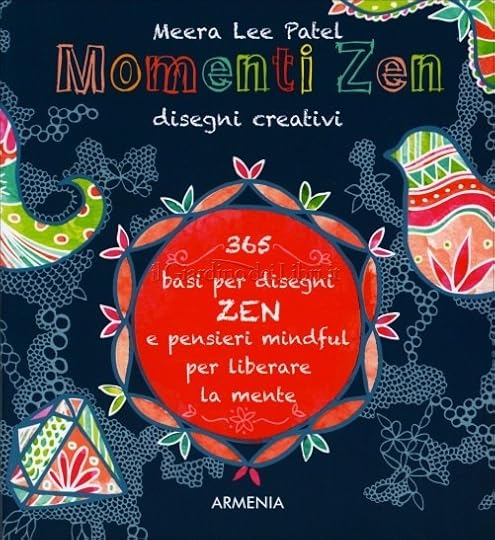
Se imparerete ad ascoltarlo, il vostro intuito si svilupperà fino a diventare una fonte interiore di amore, verità e saggezza, sempre a vostra disposizione. Possiamo chiudere gli occhi, entrare dentro di noi, e ricevere sempre la giusta guida.
—SWAMI DHYAN GITEN
INDONESIAN
Intuisi dan Penyembuhan
 Koleksi kutipan dari Swami Dhyan Giten
Koleksi kutipan dari Swami Dhyan Giten
Bagaimana kita bisa belajar untuk mendengarkan bisikan batin kita? Bagaimana cinta berhubungan dengan kesendirian? Apakah itu intuisi? Bagaimana kita dapat mengembangkan kehadiran kita, sehingga kehadiran dan intuisi kita menjadi sumber kasih, sukacita, penyembuhan dan kebijaksanaan dalam hubungan kita dengan orang lain? Apa perbedaan antara kepribadian dan batin/diri-sejati? Bagaimana kita dapat mengembangkan batin kita melalui meditasi? Bagaimana pria dan wanita dalam mengekspresikan diri ke luar dalam bentuk hubungan? Apakah itu pencerahan?
The Silent Whisperings of the Heart berisi koleksi kutipan dari Swami Dhyan Giten tentang kesadaran, meditasi, intuisi, hubungan, batin pria dan wanita, penyembuhan, bekerja dengan orang-orang berdasarkan cinta dan kesadaran, kebenaran, kreativitas, keheningan, kebijaksanaan dan pencerahan. Setiap halaman menginspirasi Anda untuk melihat diri sendiri dan kehidupan dengan cara baru, dari dimensi baru. Koleksi kutipan ini adalah sebuah pengantar perspektif dari Giten terhadap kehidupan. Ini adalah kutipan dari buku tersebut yang mencakup dua wilayah yaitu intuisi dan penyembuhan.
1. Intuisi & Batin
Intuisi berarti belajar untuk mendengarkan bisikan hening dalam batin kita sendiri.
Intuisi adalah guru dalam batin kita, sumber cinta, kebenaran dan kebijaksanaan, dalam kehidupan.
Intuisi pada dasarnya berarti untuk mengembangkan kepercayaan yang lebih mendalam dalam diri kita sendiri. Intuisi berarti untuk mengembangkan kepercayaan yang lebih mendalam di hati kita dan batin kita.
Translation: https://henkykuntarto.wordpress.com
Read the whole article on:
https://henkykuntarto.wordpress.com/2010/02/23/intuisi-dan-penyembuhan/



